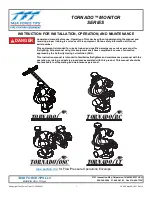
CentriMag
TM
Circulatory Support System Operation Manual (US)
Page 89 of 126
© 2019 Abbott – Document No PL-0047, Rev 11 (December 2019)
8.2 Console Alarm/Alert Strategy
A normal operating condition is free of any alerts or alarms and is classified as a green
state of operation. The Console alarm/alert strategy is based on the following philosophy.
Audio and visual advisories are divided into two groups, System
Alerts
and System
Alarms
, to warn the operator of conditions that may interrupt patient support or damage
the Pump, Motor, or Console.
Alert Advisories
activate when the System is about to, or
has entered, an unsafe but resolvable operating state (yellow state). In the event of an
Alert condition (medium priority)
, the Console continues pumping operation.
Alarm
Advisories
activate when the System is about to, or has entered, an unsafe state of
operation which may be hazardous to the patient, operator, or device (red state). Except
for the
MOTOR ALARM
condition, in the event of an
Alarm condition (high priority)
, the
Console stops the Pump.
illustrates the fundamental strategy.
Table 10: Main Console Alarm/Alert Advisory Strategy
Operating State
Advisory Level
Anticipated Operator Response
Green
Yellow
Red
None
Alert
Alarm
None
Resolve Fault Condition
Resolve Alarm Condition
or Switch to backup
Console/Motor/Flow Probe
If an alarm or alert condition occurs, the audible advisory sounds along with a visual
message indicating the cause(s) of the alarm/alert condition on the alphanumeric display.
Depressing the ALARM ACKNOWLEDGE keypad temporarily mutes the audible alarm for
most alarms and the audio paused symbol is displayed on the Console and the Monitor.
There are three high priority alarms which may not be muted (
). For all
alarms/alerts, the alarm/alert message is continuously displayed on the Console display
as long as the alarm/alert condition exists. The visual display of the alarm/alert condition
and the audio paused symbol will be automatically removed provided: a) the condition was
acknowledged by depressing the Alarm Acknowledge button, and b) the condition was
resolved. If the visual indication of the alarm/alert condition remains, the user either failed
to acknowledge the condition by depressing the Alarm Acknowledge button, the
alarm/alert condition has resolved and reoccurred, or the condition has not been
successfully resolved.
Note: Should the alarm/alert condition be successfully resolved but the visual indication
persists, the user may clear the visual display by depressing the Alarm Acknowledge
button. Persistence of the visual display after depressing the Alarm Acknowledge button
indicates the alarm/alert condition has not been resolved or has reoccurred. If the
alarm/alarm condition cannot be resolved, the user should refer to Table 13 or Table 16 to
determine the appropriate operator response for the specific Alert/Alarm which has
occurred.
















































